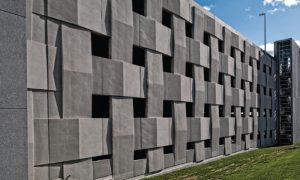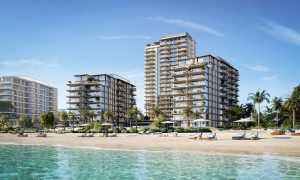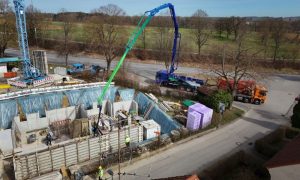Heritage Heart
Big Project ME visits the Al Bait hotel, part of the Heart of Sharjah project.

RELATED ARTICLES: Sharjah hotel developer faces historic challenge | Sharjah Police urge greater onsite safety after fatal accident| Work on $2.09mn-worth educational project begins in Sharjah
Sharjah has always been something of an anomaly in the UAE construction industry. Although the city is the third largest in the UAE, not much is heard from it about megaprojects and the like. Unlike its near neighbour, Sharjah has always seemed content to eschew the high-profile and focus on the necessary.
However, the last few years has seen the governance of the emirate take proactive steps to raise the city’s profile on the regional and international stage. In true Sharjah style, however, how this is achieved is in stark contrast to its neighbours in the GCC.
While the likes of Dubai and Doha have gone for the headline-grabbing retail and tourist orientated developments, Sharjah has embraced projects that serve to highlight its growing reputation as the UAE’s cultural hub.
Following the announcement that Sharjah would be the Capital of Islamic Culture for 2014, the city launched a series of projects, including a $38.1 million artificial island that would house an open air amphitheatre.
Now, however, it becomes clear that Sharjah’s ambitions extend even further, with the announcement that the oldest part of the emirate will be developed as a heritage project that aims to become a UNESCO World Heritage site. Described as the largest heritage project in the UAE, the Heart of Sharjah project is a five-phase, 15-year historical restoration project that will revamp the traditional heritage areas of the city. It will feature commercial, cultural and residential segments, while also housing tourist and trade destinations, says Marwan Bin Jassim Al Sarkal, CEO of Sharjah Investment and Development Authority (Shurooq).
Working in tandem with the Sharjah Department of Public Works and a number of government bodies and departments in the emirate, Shurooq aims to renovate traditional houses into boutique hotels,restaurants, art galleries, shopping centres and museums, amongst others.
With the project about to commence, Big Project ME was invited to visit the core site of the Heart of Sharjah, where work is underway to restore three traditional houses in preparation for the mobilisation of work on the Al Bait Hotel, a $33 million boutique luxury hotel.
“Phase 1 of the Heart of Sharjah development is the Al Bait Hotel. It is not just the most important part of the project, it is also the biggest part,” says Ammar Adeeb Tawfeek, senior project manager at Shurooq. “This is the first traditional hotel of this size, standard and quality in the UAE, as far as I know. Our project has 53 keys and although there are some similar projects in Dubai and Abu Dhabi, they are not at this level.”
Although construction on site hasn’t started yet, as the main contractor is yet to be appointed, Tawfeek says that the team behind the project have been busy attempting to alleviate the major problems that are likely to crop up during construction.
“We’re trying to sort out all of the anticipatedproblems and challenges and clear the construction site. One of the big challenges is the services. That is, how do we bring in the services? This is an old area and bringing in the necessary equipment to upgrade the services here. This means all the existing infrastructure – the power, water, drainage and gas, Etisalat and the roads and parking.
“These are major issues for any old area, because most of the service installations were done years ago. Some of them, the authorities don’t even have records for. What we’re doing right now is trying to investigate the services that have [been found] and update the information that the authorities have. We’re working with the authorities [to resolve this] – with SEWA, the municipality and the planning department,” he explains.
The scope of the project poses additional challenges to the incoming contractor, Tawfeek cautions, pointing out that part of the construction process involves following strict guidelines to protect the old and fragile structures. With no foundations to speak of, there’s a risk of settlement for the walls of someof the structures due to the high water table.
Therefore, these will need to be supported by new foundations or entirely replaced if in bad condition. “Everything that will be done here will be under close supervision by us and the heritage department,” he claims.
An additional complication is the location of the project itself. Situated in an area known locally as Bank Street, the construction team have been working against the clock to ensure that the contractor will be able to have unhindered access to the site.
“The area is full of banks, companies and residential buildings, so providing all the materials to the construction site, providing access to the site, it will be a challenge to the contractor. What we’re trying to do now is put a proper plan in place. We don’t want to cause any disturbances to the people living and working here. Of course, as a construction site, there will be some disruption, but we’re trying to minimise them.
“You know, we don’t even have a proper location or space for the site offices. We need to find a solution to these challenges,” Tawfeek asserts. “It’s difficult, a real challenge. But we’re working closely with the authorities to do physical site inspections, site surveys and to update information. We’ve dug trial pits on-site and we’ve seen whether the services are there.
We’ve started coordination with the authorities and we’ve prepared drawings on how to relocate the services outside, and how to upgrade the services as well. Hopefully, we’re at the final stage of all the relocation of the services and the new service corridors. We have to do it very carefully, because this is an old area and you have to do the excavation manually at first.”
With only two access points available to the contractor, the limited space is going to pose some significant challenges, Tawfeek warns. Because the site is so small, space to bring in and store machinery and labour will be extremely constrained. “It’s not going to be easy. It will be a serious challenge. But hopefully the contractor will be capable of doing it.”
The design and tender processes for the hotel are finished, the project manager tells Big Project ME. Three contractors have been short listed to be awarded the project. The evaluation criteria for their appointment are based on their construction history, as well as their financial and technical capabilities.
While the three older houses (and a smaller unit and majilis) will be restored and built in the traditional manner by theheritage department, Tawfeek says that the hotel itself will be built according to tried and tested modern construction methods.
“We don’t need a specialised contractor for this project,” he says. “The project boundary area is about 12,500sqm and the built area is between 7,500sqm and 8,000sqm. The buildings for Al Bait Hotel and the adjacent souk will be G+1. In some cases, we’ll have G+2, but there definitely will be no high-rise buildings.”
He adds that there is a preference to use Sharjah-based construction companies, given that the project aims to encapsulate the spirit of the city. “Even if a contractor or a company is based in Abu Dhabi or Dubai, they should have a licence to operate in Sharjah,” he insists.
Attempting to explain the scale of the project, Tawfeek says that Phase 1 of the project will see the reconnection of Souk Saqr to Souk Al-Arsa, two Sharjah landmarks, through the rebuilding of the Souk Al Shanasiyah on Bank Street. In addition, the developer intends to incorporate the fabric of the old city into the development through the use of semi-public spaces in the hotel. ‘Sikas’, alleyways, will run between the buildings, providing avenues for the public to move through. The hotel willalso have no outer fence, meaning visitors will be able to wander through the hotel and into the souks, creating the experience of wandering through the old city.
All of this construction and redevelopment means that there will be significant changes to the existing urban landscape around the Heart of Sharjah. Already, three buildings near the Al Hisn Souk have begun to be demolished, with more to come.
“Demolishing these buildings is not easy. It’s a very complicated and timeconsuming process. Most of these buildings are occupied by companies and are of course owned by individuals. So in order to do the demolishing, we need to offer compensation. Sometimes, with some of the projects, we’ll go into joint ventures with the landlords. This is an opportunity for people to participate in the development of the Heart of Sharjah,” Tawfeek points out.
The project will eventually see the closure of Bank Street, with the demolition of the buildings clearing space for the development.
Shurooq officials say that they will work with the Sharjah RTA and the Planning Department to determine the impact of such a strategy.
“In my opinion, this will be a very important project for Sharjah. The Al Bait Hotel is the first project in the development. Hopefully this will boost the development process and will be the key for the future development of the whole project,” says Tawfeek, as he brings to a close a fascinating tour of a project that will certainly make the region sit up and take notice of an often ignored cultural capital.




















